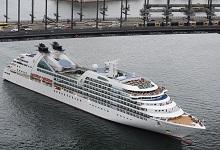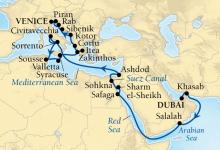Recently Viewed Cruises
- Odyssey, Red Sea & Adriatic Gems ex Dubai to VeniceAdd to favourites
- Pride, Wonders of Arabia & Egypt ex Dubai to AthensAdd to favourites
- Classica, Dubai Oman UAE ex Dubai RoundtripAdd to favourites
- Atlantica, Dubai Oman UAE Cruise ex Dubai ReturnAdd to favourites
- Atlantica, Dubai Oman UAE ex Dubai ReturnAdd to favourites
- Royal Caribbean International raises the bar
- Classy Astor fills gap in market
- Oceanic Discoverer
- Ab Fab Oosterdam
- Catch up on Cruising: Latest cruise news in bite size
- Frequently Asked Questions
-
Odyssey, Red Sea & Adriatic Gems ex Dubai to Venice
Nights 32 Ship Seabourn Odyssey Star Rating 
Departs Dubai, United Arab Emirates Sailing 2013: 10 Apr Ports of Call Dubai, Salalah, Safaga (Luxor), Sharm el-Sheikh, Sokhna, Suez Canal, Ashdod (Jerusalem), Sorrento More Rome (Civitavecchia), Monastir, Valletta, Syracuse, Itea, Zakinthos, Corfu, Kotor, Sibenik, Rab Island, Piran, Venice Please enquire about this cruise for pricing.


32 Night Cruise sailing from Dubai to Venice aboard Seabourn Odyssey.
Seabourn Odyssey is the first in a new-class of ships for Seabourn that will accommodating just 450 guests in 225 luxury suites.
Although, at 32,000 GRT, Seabourn Odyssey is more than triple the size of Seabourn Pride, Seabourn Spirit and Seabourn Legend, she was the smallest new ship being built by any major cruise line, and her guest capacity is just twice that of the smaller sisters, creating the highest space-per-guest ratio in the industry. Seabourn Odyssey was built by the Italian company T. Mariotti S.p.A., located in Genoa, Italy and named in Venice in June of 2009.
On that occasion, the guests on board for the maiden voyage were all honored as the ship's godparents, and a plaque with their names was permanently mounted on a wall inside the ship.
Seabourn Odyssey was designed by the same architectural team, Petr Yran and Bjorn Storbraaten, who designed the original Seabourn ships. Seabourn Odyssey's 225 ocean-view suites are divided into 13 categories, with interior measurements from 295 to over 1,200 square feet. Ninety percent have private verandas, which add from 65 to over 350 square feet of additional private living space.
Highlights in accommodations are the exceptional Wintergarden Suites, which have a private glassed-in Solarium with a soaking tub and a lunging bed. This suite also features a veranda that is bowed out, giving wonderful views long the side of the ship. The Signature Suites, located all the way forward on Deck 7, have over 900 square feet of inside space and a spectacular wrap-around veranda of 353 square feet. In addition to more larger suites, Seabourn Odyssey's additional size is utilized to create more open deck space, and a variety of public rooms and dining venues.
Highlights of this cruise:
Dubai
The United Arab Emirates is strategically located at the crossroads of East and West, and the traditional trading routes from Asia and the Far East to Europe and further afield are even more significant today than they were hundreds of years ago. Nestled at the very heart of the Islamic world, the country is unique in its embrace of the Western world. Here you can see the contrasts of the nomadic Bedouin people, and the opulence and splendor of the Sheiks, set against a backdrop of Western lifestyles.
Salalah
Salalah, Oman's ancient incense capital is an oasis with lush vegetation resulting from seasonal monsoons. The city's roads wind through groves of coconut, papaya and banana trees, and roadside stands sell fresh fruit and coconut water. The tropical atmosphere is a striking contrast to the otherwise arid landscapes of the Arabian Peninsula. Even the Queen of Sheba fell under the spell of the area's treasure far greater than gold, and sent gifts of frankincense to impress Solomon. Today, the beautiful sand beaches, cultural history, archaeology and natural diversity draw visitors to this ancient paradise.
Safaga
Located on the Egyptian side of the Red Sea, the port of Safaga is the gateway to some of Egypt's most memorable destinations: Luxor, Karnak and Thebes. Luxor has often been called the world's greatest open-air museum, and the number and preservation of the monuments in the area are unparalleled anywhere else in the world. The ancient Egyptians called Luxor "The City" and Homer called it the "City of a Thousand Gates." The troops of Napoleon, coming upon its grandeur, broke into spontaneous applause. The pharaoh's tombs in the Valley of the Kings, and the colossal temples of Luxor and Karnak capture the imagination with splendors that have survived the centuries.
Sharm el Sheikh
Some of the best snorkeling and diving in the world is found at the southern tip of the Sinai Peninsula. Here, on a slender promontory where the Gulf of Aqaba meets the Straits of Tiran, Sharm el Sheikh offers access to serene sand beaches, wind-carved cliffs and a wonderland of colorful fish and coral reefs. The area is revered as a place of prophets and miracles, including St. Catherine's Monastery, the most important religious site in Sinai, situated at the base of the mountain where Moses received the Ten Commandments.
Ashdod
The largest port in Israel, Ashdod is a gateway to Jerusalem, the 5,000-year-old walled city that is considered sacred to more than a third of the people on Earth. Numerous sites exist nearby, including the Jewish sacred Western Wall, and the Church of the Holy Sepulchre said to be the site of Calvary and to contain a piece of the true cross.
Meander along the seaside promenade, or dip your toes in the Dead Sea waters, long known for their health benefits. Visit the Bar-Gera Museum to view a collection of art by artists who were either banned or persecuted by the Nazis and other fascist governments. The Yad Vashem Memorial Museum is dedicated to the six million Jews who lost their lives during the Holocaust.
Rome
Originally built by Emperor Trajan who had a villa here, Civitavecchia has flourished as a major port for Rome since the 13th century. Today it is an important ferry terminal and for many travelers the gateway to the Eternal City, Rome. The Renaissance fortifications that surround the harbor area were begun by Bramante and completed by Michelangelo in 1535.
Monastir
Located on the Mediterranean Sea, Monastir has a well-preserved ribat that was used to survey the horizon for approaching ships in ancient times. Today it boasts thriving resorts along the shining beaches, and offers access to the picturesque historic medina in nearby Sousse, a UNESCO World Heritage Site that was used as a location for the film "Raiders of the Lost Ark."
Valletta
Occupied successively by the Phoenicians, Greeks, Carthaginians, Romans, Arabs, French and British, Malta has been of strategic importance throughout history. A British Crown Colony until 1964, Malta received the George Cross for its valiant resistance to German occupation in WWII. The island's rich heritage is reflected in the architecture of Valletta, the current capital, and Medina, the capital until 1565. In Valletta the Knights of St. John built such masterpieces as St. John's Co-Cathedral and the Palace of the Grand Masters, along with the fortifications that guard the town's magnificent harbors.
Itea
Itea is a small bathing resort and port at the end of a bay not too far from the ancient port of Delphi. The hills are covered with olive trees belonging to the sanctuary of Apollo in ancient times. Referred to as a "sea of olives," their production is now an important part of the local economy.
Kerkira
A scant few miles off the Albanian coast lies the island of Corfu, one of the most richly endowed of all the Greek Isles. Praised by Homer in "The Odyssey" and selected by Shakespeare as the setting for "The Tempest," the island retains evidence of cultural heritage from each of its past rulers - Byzantium, Venice, France, Russia and Great Britain. Rolling acres of olive groves, small orchards of lemon and orange trees, tall cypress, oleander, and myrtle bushes lend a lush, verdant look to the island. While the oldest part of Corfu Town has cobblestone lanes so narrow only pedestrian travel is possible, the modern sector has wide avenues. Residents boast that its "Spianada" is the largest and most beautiful square in all Greece.
Kotor
One of the best preserved medieval towns of the Adriatic, Kotor is protected by UNESCO. Between 1420 and 1797, the area was under the rule of the Republic of Venice and the Venetian influence can be seen in its architecture. The Gulf of Kotor is sometimes called the southernmost fjord in Europe, although it is actually a submerged river canyon. The overhanging limestone cliffs of Orjen and Lovcen complete one of the Mediterranean's most beautiful landscapes.
Sibenik
Sibenik lies in the middle of the Croatian Adriatic Coast, at the mouth of the Krka River, one of the most beautiful karst rivers in Croatia. Limestone mountain crests, small valleys and striking plateaus characterize this scenic region. A picturesque town, Sibenik was originally built on a small island, surrounded by a high wall and towers. The historic old town of Sibenik is rich in cultural and historical monuments. The most representative among them is the famous Cathedral of Sibenik, an important architectural Renaissance building listed as a UNESCO World Heritage Site. Today, Sibenik is the administrative, political, economic, social and cultural center of a county, which stretches 62 miles along the Croatian Riviera between the Zadar and Split.
Rab Island
One of the cluster of islands that decorate the Gulf of Kvarner at Croatia's northern end. The familiar Venetian-style campaniles bristle above the medieval town, whose narrow cobbled streets wind to unexpected small piazzas where people gather for coffee and the latest gossip. Stroll the serpentine Lungo Mare Promenade along the waterfront, or investigate one of the many churches that dot the town. Across the island, one of Europe's last remaining oak forests still survives.
Piran
The walled town of Piran extends like an open palm on its narrow peninsula, welcoming you to yet another enchanting Venetian outpost on the Istrian coast. The medieval streets wind inward toward the central square, with its statue of the town's famous violinist son. Inviting destinations are on every side, from the Holy Trinity Church in nearby Hrastovlje, with its fresco of the Danse Macabre, to the fabulous limestone caves of Skocjan, a UNESCO World Heritage Site, or the venerable stud farms of Lipica, the home of the Lippizaner horses.
Venice
The first settlement of the marshy islands in the lagoon was for protection from barbarian tribes that terrorized mainland farms and villages. Island living quickly led to the development of skills in handling boats, then ships. Maritime trade conducted by shrewd merchants brought great wealth, which permitted the building of palaces, churches and monuments. The city became the center of the vast Venetian empire, its name forever summoning visions of grandeur, magnificence, richness, graciousness and beauty. Although later linked to the mainland, first by a railway bridge built in 1848 and then by a motor causeway in 1930, this island city will always be considered the "Queen of the Sea." There are no cars in Venice; all transportation is by boat or on foot along the time-worn, cobblestone streets and across some 400 bridges that span the city's 177 canals. Enchanting Venice truly offers an atmosphere that exists nowhere else.





